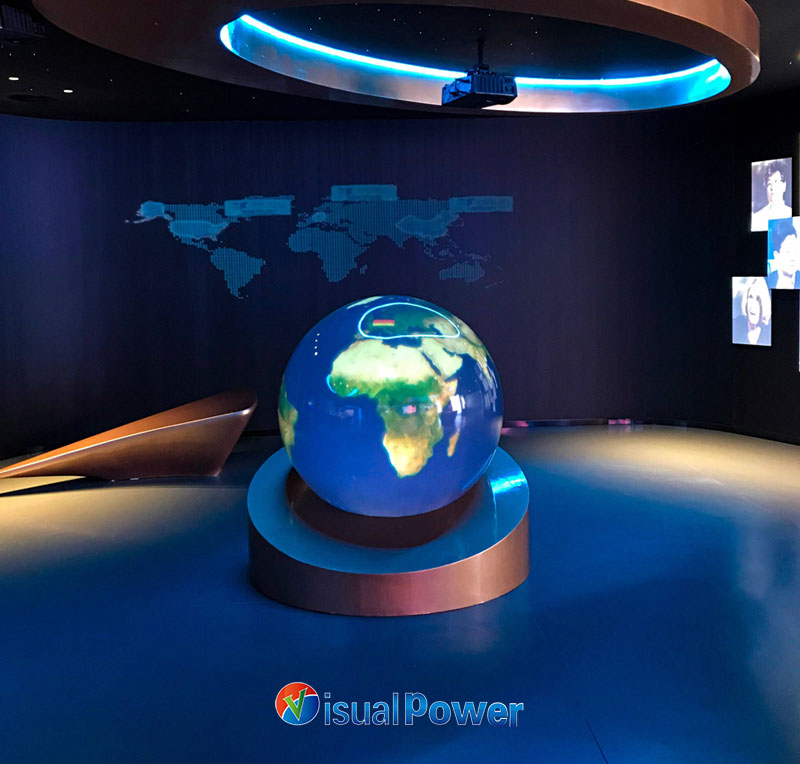Kategorien
- News (80)
- Fallstudie (6)
That year, when I was planning an immersive exhibition in Seoul, I participated in the design and content arrangement of a Kugel-LED-Anzeige by hand for the first time.
When the sphere was hoisted into the center of the exhibition hall and lit up, I felt for a moment that it wasn’t the screen playing content, but the entire space breathing. The spherical picture has no boundaries, and the information approaches the audience in a gentle and enveloping way. In diesem Moment, I knew that this was not a device; it was an evolved version of some medium.

We used to tell stories on the plane – television, mobile phones, posters. They were the worlds “framed”. Jedoch, the emergence of spherical LED display screens has completely broken through this framework.
In an airport waiting area project, our team placed a 2.5-meter-diameter sphere in the center of the waiting hall, with weather forecasts, flight updates and local cultural images scrolling at a high frequency. People walk around it. The information switches automatically according to the perspective. There is no direction and no “Vorderseite” oder “zurück”. It doesn’t “sprechen” to you, Aber “coexist” with you.
I have found that the value of spherical leds does not lie in their “visual amazement”, but in making people instinctively want to approach them. It is like a signal source in space, being both the center and the flowing boundary.
Many people think, “It’s just about assembling the screen into a spherical shape. What’s so difficult about that?” — You’ll know until you participate in it yourself.
The precise arc of module splicing needs to be calculated. The structural stress caused by thermal expansion and contraction under different sizes cannot be ignored. The control system should not merely meet the requirements of playing content, but also achieve multi-faceted synchronization and real-time signal response. Especially in a 360° viewing scenario, blind spots and delays can directly undermine the overall experience.
I’m not from a hardware background, but I know that a mature sphere LED display is not a “decoration”; it is the product of system design. A single mistake in wiring or a miscalculation of the Angle can cause the spherical surface to lose balance and even lead to visual fractures.

Many customers initially thought that this kind of screen could only be used in art galleries or science and technology museums. But in recent years, I have seen it increasingly common in retail stores, city landmark squares and the courtyards of shopping centers.
There was once a brand that hung a 0.8-meter-long small ball at the entrance of its store, continuously playing animations about the product’s functions and trendy keywords. Customers always subconsciously take an extra look, Und einige machen sogar Fotos und veröffentlichen sie in sozialen Medien. Für Marken, Dies ist keine Werbung, sondern eine Möglichkeit, sich mit Menschen zu verbinden.
Der Ball kann die Grenze zwischen brechen “Ich bin das Publikum und du bist der Bildschirm”. Es ist kein Werkzeug mehr zu sein “beobachtete”, Aber eine Existenz, die Menschen aufhören lässt, umgeben und wahrnehmen.
Meine persönliche größte Sorge ist, dass das Denken der traditionellen Inhaltsplanung nicht mehr anwendbar ist.
In dieser Ausstellung, Wir mussten die aufgeben 16:9 logic and instead think: How do images flow continuously on a sphere? How can characters avoid being pulled and deformed by the “Sphere Pole”? Where should the text information be placed so that the audience can read it? How should the sound be set so that people both inside and outside the space can hear it without disturbing each other?
That is a process of transforming from “narrating content” Zu “arranging experiences”.
Just like when you approach that ball, the screen won’t show fixed clips. Instead, it adjusts the focus, magnifies the details, and guides the rhythm based on your position. You are no longer a bystander but a part of the narrative line.

Ehrlich gesagt, I have never thought that the sphere LED display is a “necessary device”. It’s not the kind of tool you have to pretend to be, but what it can bring is the shaping of the character of the space.
In urban renewal projects, a slowly rotating sphere is like the “heartbeat” of that square. It doesn’t speak, yet it can convey a sense of “place”.
This is the part I value most: it’s not “bright”, Aber “Geschenk”.
The spherical screen is not a “show-off” of screen splicing, but a new means of expressing spatial information.
Its perception is dominated by the audience, not in a positive or negative direction but in a circular one.
The technical requirements are extremely high: structure, playback, synchronization, every link needs to be predicted in advance.
The way of content creation needs to be restructured: like writing “flowing poems” rather than “shooting an advertisement”;
The application scenarios are gradually becoming more accessible to the general public and have become the “voice” for urban spatial information.
Ich sage oft: sphere LED display is a kind of “verb” in space – not placed there for people to see, but a tool to evoke behavior, participation and connection.
It can help us express what we couldn’t say before, turn information into atmosphere, and make space “breathe”.
Es sollte also nicht nur bei Ausstellungen erscheinen, aber auch in den Städten, Gemeinschaften und Handelsräume, in denen wir wirklich leben.